#goliathia
Explore tagged Tumblr posts
Text
Fossil Novembirb: Day 15 - Oasis in the Desert

During the Late Eocene and Early Oligocene, the environment of Jebel Qatrani formation of Faiyum, Egypt was as lush as you could imagine, with tropical forests, and a vast system of wetlands, lakes and rivers connecting to the warm Tethys Sea. As you would expect, such a place was teeming with birds. The birds living here would have no idea that 30 million years later, the Sahara desert would bury all this greenery. But for now, it is an oasis where birds of a feather flock together.
Goliathia: One of the earliest known relatives of the shoebill, arguably one of the most awesome birds alive today.
Nycticorax: An early member of the modern night-heron genus. It is not named, but can be assigned to the genus thanks to the shape of its limb bones.
Xenerodiops: An early member of the stork family with a short, recurved beak. It probably fed like modern wood storks, probing the water with the beak open, snapping it shut on passing fish.
Nuphranassa: A member of the modern jacana group, but much larger than any living species at about the size of a chicken.
Janipes: Another large jacana. Not as large as Nuphranassa, but still larger than any modern jacana. One must wonder what these guys were walking on.
Palaeoephippiorhynchus: An early stork well known from this period. It closely resembles the saddle-billed and black-necked storks, but was markedly smaller in size.
Eremopezus: A very poorly know flightless palaeognath known from a few fragmentary limb bones. Probably related to modern ostriches.
#Fossil Novembirb#Novembirb#Dinovember#birblr#palaeoblr#Birds#Dinosaurs#Cenozoic Birds#Goliathia#Nycticorax#Xenerodiops#Nuphranassa#Janipes#Palaeoephippiorhynchus#Eremopezus
56 notes
·
View notes
Text

Fossil Novembirb: Day 15
A Goliathia eats a lungfish while a Nycticorax sp. watches
30 notes
·
View notes
Text
Very late on this one but I think theres some cool stuff to talk about.
I actually covered this formation extensively a few years ago when giving the Wikipedia page a major overhaul at the request of someone on discord, so the research phase for Josch was mercifully easy (at least for me, not so much for those making the reference size chart).
Really one of the main things that the research focused on was which localities to choose. For reference, Jebel Qatrani spans the Eocene-Oligocene boundry and has localities representing different time intervalls. For example, locality L-41, which is the single most specious, was deposited during the Late Eocene, localities A and B right after the boundry and localities I and M are among the most recent. After some debating I and M kinda cristalized into the main ones to use, they are pretty close together so the fauna was likely to overlapp a good deal, they had some iconic animals and they also preserve a bulk of the bird fauna, which really helped fill lots of the space to not overcrowd with mammals.
Obviously my personal highlight was the featured crocodilian, Eogavialis africanum. Right out of the gate its an interesting one. Traditionally, Eogavialis, like other closely related forms (informally "thoracosaurs") have been recovered as some type of gharial, generally closer to Indian Gharials than Tomistoma (in old phylogenies featuring Tomi as a crocodylid, thoracosaurs are still deemed gharials proper).
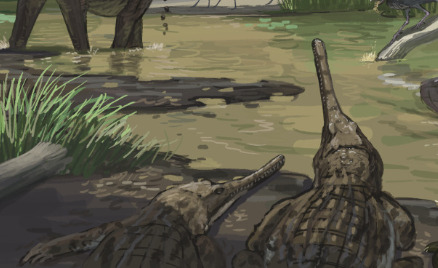
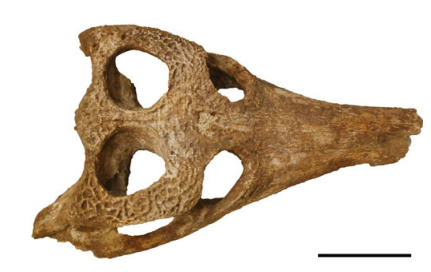
Now I initially had like three whole paragraphs typed on why I don't think this is the case, but for brevity's sake I'm going to save that for a future post on thoracosaurs in general (perhaps its something to cover after I'm done with mekosuchines). So for now, just know that tho it could be an early African gharial, its also possible that Eogavialis is a member of a much more ancient, non-crocodilian group of Eusuchians that just happens to look similar to gharials and that went extinct during the Miocene.
Also fun fact, the patterns and colours are based on modern day broad-snouted caimans.

Also while not featured in this piece I wanna give a shout out to "Crocodylus" megarhinus, a more robust crocodilian from the formation. As you can guess from the "", its no longer thought to belong to Crocodylus but is its own, still unnamed genus, interestingly closely related to the enigmatic mekosuchines endemic to Oceania. The size chart below also features Crocodylus articeps, the slender jaws at the very bottom. Though this species was long deemed a juvenile "C." megarhinus, comparisson with actual juveniles of the latter shows this to be obviously false. Alas the holotype has been lost and it is now deemed a nomen dubium.
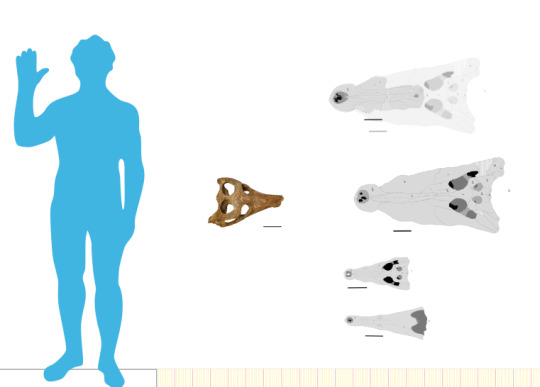
I also wanna give a brief shout out to the bird fauna, which is quite interesting in its own right and features a lot of taxa that match the swampy environment depicted here. For instance there's Palaeoephippiorhynchus, a large stork related to saddle-bills, marabous and jabirus and in a similar size range. There's also Goliathia, a "giant" shoebill. Though, as it turns out, the holotype is smaller than a modern shoebill and one of the referred specimens is only slightly more robust in some ways and not in others. So while interesting, its name (envisioned for what was assumed to be a heron) is not that fitting anymore. Speaking of heron, there is also Xenerodiops, with its uniquely shaped bill. Some researchers have argued that this genus was a type of night heron based on a humerus, though here it is depicted as more generalized given that the humerus and holotype bill have no direct evidence for having belonged to the same animal.
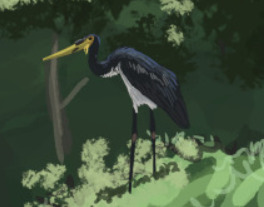
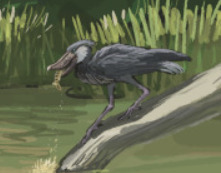
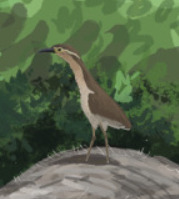
My personal favourites among the birds are the local flamingos and lilly trotters. Flamingo are represented through remains similar to those of Palaelodus (which I talked about in greater detail here and here) and thus likely belonged to that genus or another palaelodid. In short, these birds likely already had a diet not dissimilar to modern flamingos, but lacked the extreme bill curvature. Lilly trotters are better known from the formation and represented some of the earliest records of this family. Three species in two genera have been named, with this one in particular being Janipes, here depicted similar to a pheasant-tailed jacana, which is closely related to at least one of the two Jebel Qatrani jacanas (Nupharanassa specifically). It's been noted that all jacanas from this formation are larger than their modern kin.
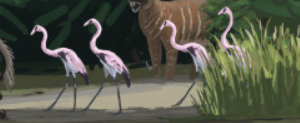

Obviously theres a lot more cool stuff about the formation, including the incredible diversity of hyraxes, the presence of the weird ptolemaiids, three different elephants, the bizarre Arsinoitherium, early sirenians (really this place was a hot spot for afrotheres) and a vast number of primates. But all this goes beyond what I'm most familiar with.
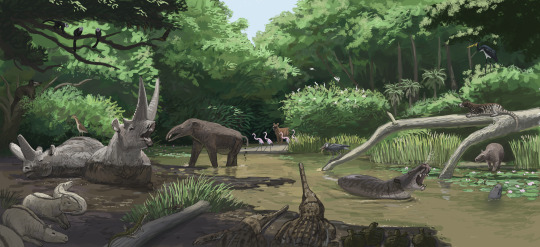
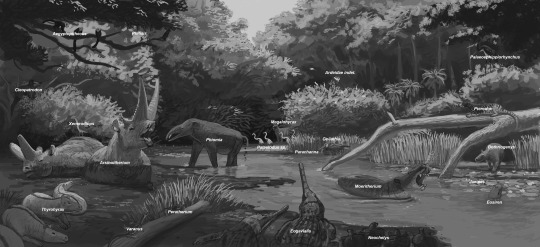
Results from the Jebel Qatrani formation #paleostream!
Arsinoitherium might be the most iconic animal from here but that doesn't make the rest of the fauna less interesting!
#jebel qatrani formation#gebel qatrani formation#fayum#egypt#paleontology#palaeoblr#long post#xenerodiops#palaelodus#janipes#jacana#flamingo#crocodylus megarhinus#eogavialis#eogavialis africanum#thoracosaur#croc#crocodile#gharial#eusuchia#oligocene#prehistory#goliathia#shoebill#paleostream
403 notes
·
View notes
Text
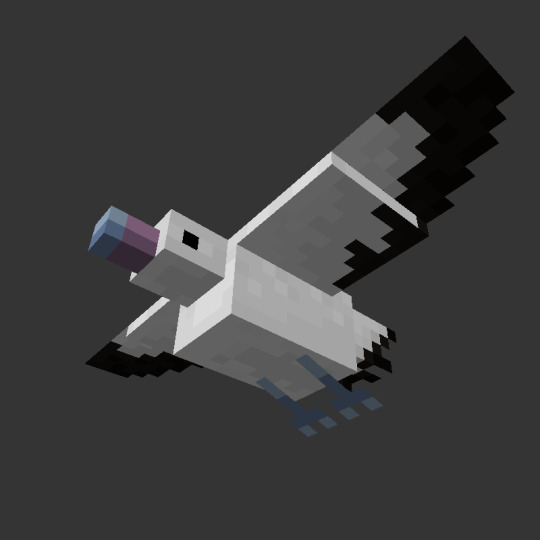
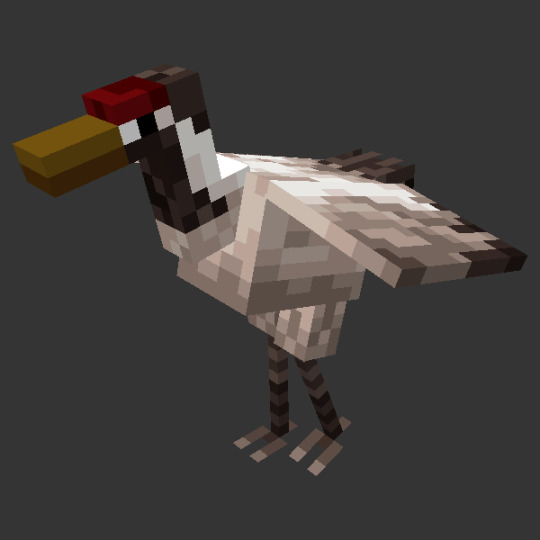



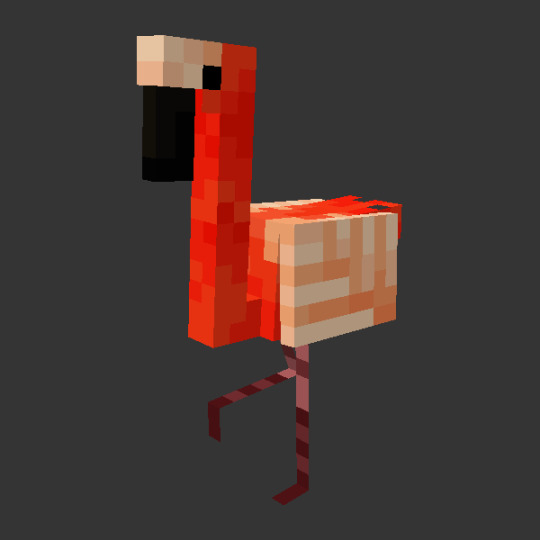
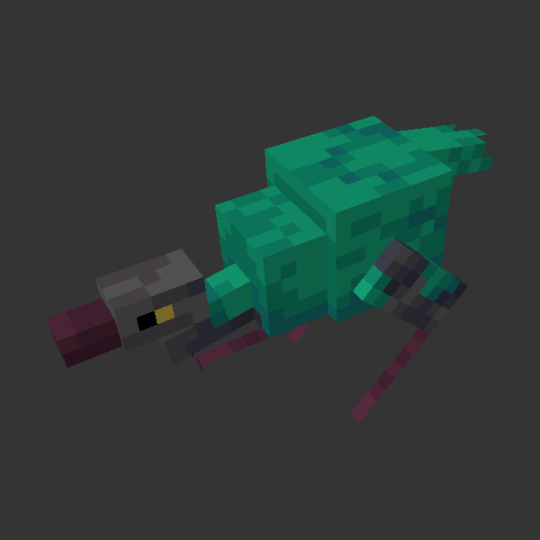
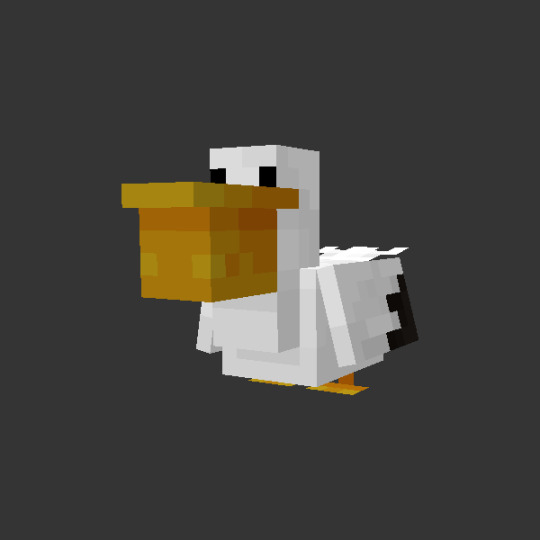
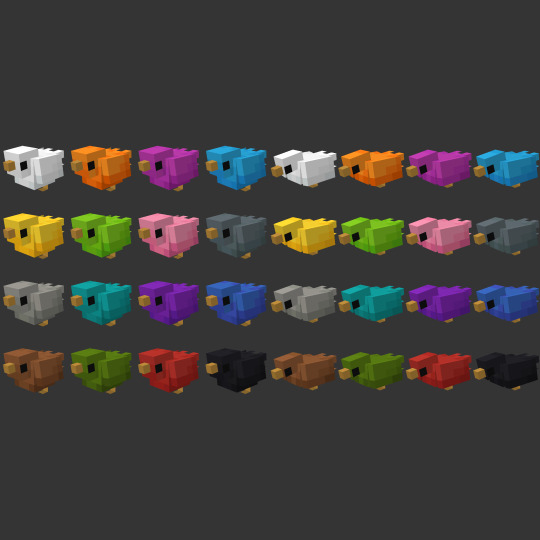
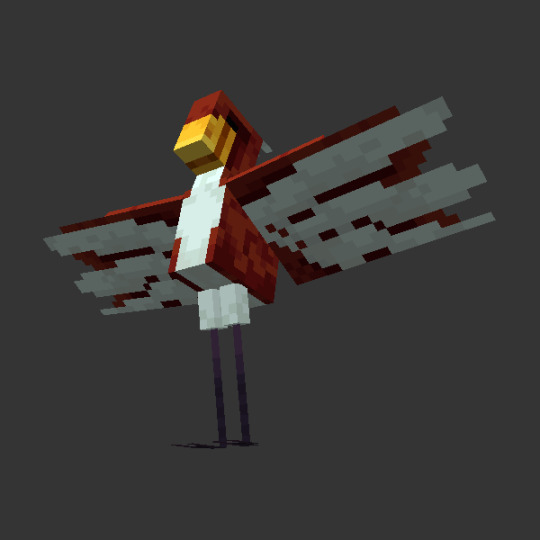
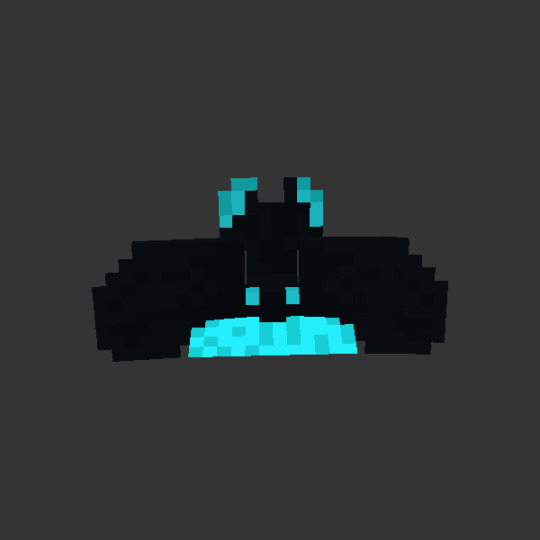

12 birds down! In order: albatross, crane, crow vulture, toucan, flamingo, hoardgull, pelican, songbird, lush caves goliathia, deep-dark bird of paradise, end potoo
These are all for my mod, Valley of Plenty! Though it's kinda an art project too, I really like modeling birds. I have a tag for the mod, everything I've posted is under that tag (on this post too!), and I'm doing an AMA right now for it, but...
349 notes
·
View notes
Text
Fossil Novembirb 15: Oasis in the Desert

Xenerodiops by @iguanodont
We FINALLY get to an ecosystem that isn't in Europe, North America, Antarctica, or Oceania - it's Jebel Qatrani Time!
(If you are as appalled as I am at the low sampling rates of fossil localities in Asia, South America, and Africa, welcome to the club, and support paleontologists who are from and work in countries from those continents!!!)
The Jebel Qatrani Formation is an ecosystem from Egypt at the end of the Eocene through the early Oligocene. It showcases the tropical forests, swamps, and marshes that existed at this time, emptying into the Tethys Sea. A wet and humid environment, it would have been a weird mixed ecosystem, with both the old and the new coexisting on the riverbanks. And, like in the forests and plains of Oligocene Europe, we see many modern bird groups show up for the first time here - and also very similar to their living relatives! This is a departure from the mammals in the region, which were unique and weird for the time period (though early members of modern groups are found here, too).
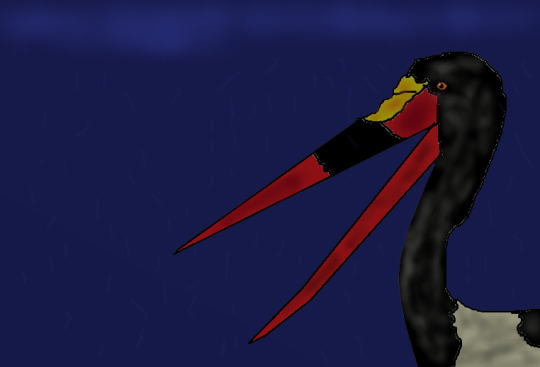
Palaeoephippiorhynchus by Bubblesorg
Being a wetland and humid environment, the main feature of the avifauna here are aquatic birds - many of which have close relatives today. Palaeoephippiorhynchus is the oldest known fossil stork, and was remarkably similar to the living Saddle-Billed Stork - even having the same upcurved bill. While it's uncertain if they're close relatives or not, it is possible that living Saddle-Bills are similar to this ancient form. There was also a mid-sized heron, a bird extremely similar to living Black-Crowned Night Herons, and Xenerodiops - a heron with a pointed and strong bill, curved downward - good for grabbing onto prey. It was a very sturdy, robust bird - even for a heron.
In addition, there was Goliathia - the fossil Shoebill! This bird had legs much like the living shoebill, and was similar enough in the limbs that it might be in the same genus! It probably lived very similarly to living shoebills, feeding on fish in the wetlands around it. What its beak would have looked like is uncertain - the closest living relative to the Shoebill is the Hammerkop, which has a very different skull. What their ancestral skull was, or what Goliathia's was, remains a mystery.

Goliathia by Antonio Rares Mihaila
But if you think I'm done with the water birds, you're very wrong - this is just the beginning! There was also an indeterminant cormorant, which had a very hooked and tapered beak; birds similar to living crowned cranes and others like living flufftails; early jacanas like Janipes which was bigger than all living jacanas but still had the large feet for floating on vegetation, showcasing the vegetation in these wetlands was sturdy enough to hold it up; other early jacanas smaller in size as well like Nupharanassa; and of course -
The Flamingos! Well, yes and no. There was an indeterminate crown-flamingo (ie in the group that all living flamingos are in), a bit bigger than a living lesser flamingo. But there was also Palaelodus - one of the "Grebe-Flamingos" or "Swimming-Flamingos", a long-lasting group of birds that first appear in the early Oligocene and lasted until possibly the Pleistocene! They looked superficially similar to living flamingos and were more closely related to them than to grebes, but they did have some similar characteristics to grebes as well - specifically having less of a kink in the neck, shorter lower legs, and flatter limb bones like those in grebes. They also had webbed feet, which would have allowed for diving or swimming. It also had a straight, conical bill, very unlike the bill of living flamingos.

Palaelodus by @alphynix
There were also perching birds, such as an early turaco very similar to the living genus Crinifer; and early eagles, ospreys, and other birds of prey that haven't really been named - mainly because they are very similar to living species, but so distant in time it seems unlikely they'd be in the same genus still... right? One, very similar to the living sea eagle, was found near the shore - indicating a similar ecology to its living relative. Another was almost identical to the living osprey, just smaller in size. And another was similar in size to living ospreys, but more robust than them. This place was filled with raptors!
Of course, I can't ignore the metaphorical elephant in the room. One of the most mysterious birds of the Jebel Qatrani is Eremopezus, a bird that has similarities to so many different groups of birds that its exact position is still a mystery. At this time it is thought to be a Palaeognath, possibly closely related to ostriches or maybe elephant birds - as the volant Lithornithids start to disappear, ratite-like Palaeognaths become more and more common. It was flightless, and probably lived similarly to modern ostriches and other ratites - as a a large herbivore, probably taking advantage of the wetland landscape and the abundance of food.

Eremopezus by @thewoodparable
Jebel Qatrani is such an important formation because it sheds light on the evolution of even more bird groups than those we see in former Laurasia (North America + Eurasia). And it is possible that many lineages we still have in Africa today have been around for thirty million years - and may have been very similar in ecology and appearance during that whole time. Given living birds react to changing climates by shifting with the ecosystems, it's possible that these lines of birds similarly followed the migration of wetlands and other habitats during the climate change to come, persisting to this day across the continent.
Sources:
Kampouridis, P., J. Hartung, F. J. Augustin. 2023. The Eocene-Oligocene Vertebrate Assemblages of the Fayum Depression, Egypt. The Phanerozoic Geology and Natural Resources of Egypt. Advances in Science, Technology, & Innovation. 373-405.
Mayr, 2022. Paleogene Fossil Birds, 2nd Edition. Springer Cham.
Mayr, 2017. Avian Evolution: The Fossil Record of Birds and its Paleobiological Significance (TOPA Topics in Paleobiology). Wiley Blackwell.
Rasmussen, D. T., S. L. Olson, E. L. Simons. 1987. Fossil birds from the Oligocene Jebel Qatrani formation Fayum Province, Egypt. Smithsonian Contributions to Paleobiology 62(62): 1-20.
71 notes
·
View notes
Text
Shoebill stork diet

When flushed, shoebills usually try to fly no more than 100 to 500 m (330 to 1,640 ft). The pattern is alternating flapping and gliding cycles of approximately seven seconds each, putting its gliding distance somewhere between the larger storks and the Andean condor ( Vultur gryphus). Its flapping rate, at an estimated 150 flaps per minute, is one of the slowest of any bird, with the exception of the larger stork species. Its wings are held flat while soaring and, as in the pelicans and the storks of the genus Leptoptilos, the shoebill flies with its neck retracted. The bill becomes more noticeably large when the chicks are 23 days old and becomes well developed by 43 days. When they are first born, shoebills have a more modestly-sized bill, which is initially silvery-grey. The juvenile has a similar plumage colour, but is a darker grey with a brown tinge. The breast presents some elongated feathers, which have dark shafts. The plumage of adult birds is blue-grey with darker slaty-grey flight feathers. The wings are broad, with a wing chord length of 58.8 to 78 cm (23.1 to 30.7 in), and well-adapted to soaring. The neck is relatively shorter and thicker than other long-legged wading birds such as herons and cranes. The shoebill's feet are exceptionally large, with the middle toe reaching 16.8 to 18.5 cm (6.6 to 7.3 in) in length, likely assisting the species in its ability to stand on aquatic vegetation while hunting. The dark coloured legs are fairly long, with a tarsus length of 21.7 to 25.5 cm (8.5 to 10.0 in). As in the pelicans, the upper mandible is strongly keeled, ending in a sharp nail. The exposed culmen (or the measurement along the top of the upper mandible) is 18.8 to 24 cm (7.4 to 9.4 in), the third longest bill among extant birds after pelicans and large storks, and can outrival the pelicans in bill circumference, especially if the bill is considered as the hard, bony keratin portion. The signature feature of the species is its huge, bulbous bill, which is straw-coloured with erratic greyish markings. A male will weigh on average around 5.6 kg (12 lb) and is larger than a typical female of 4.9 kg (11 lb). Weight has reportedly ranged from 4 to 7 kg (8.8 to 15.4 lb). Length from tail to beak can range from 100 to 140 cm (39 to 55 in) and wingspan is 230 to 260 cm (7 ft 7 in to 8 ft 6 in). The shoebill is a tall bird, with a typical height range of 110 to 140 cm (43 to 55 in) and some specimens reaching as much as 152 cm (60 in). The shoebill's conspicuous bill is its most well-known feature All that is known of Eremopezus is that it was a very large, probably flightless bird with a flexible foot, allowing it to handle either vegetation or prey. It has been suggested that the enigmatic African fossil bird Eremopezus was a relative too, but the evidence for that is unconfirmed. So far, two fossilized relatives of the shoebill have been described: Goliathia from the early Oligocene of Egypt and Paludavis from the Early Miocene of the same country. A 2008 DNA study reinforces their membership of the Pelecaniformes. In 2003, the shoebill was again suggested as closer to the pelicans (based on anatomical comparisons) or the herons (based on biochemical evidence). Microscopic analysis of eggshell structure by Konstantin Mikhailov in 1995 found that the eggshells of shoebills closely resembled those of other Pelecaniformes in having a covering of thick microglobular material over the crystalline shells. Based on osteological evidence, the suggestion of a pelecaniform affinity was made in 1957 by Patricia Cottam. Traditionally considered as allied with the storks ( Ciconiiformes), it was retained there in the Sibley-Ahlquist taxonomy which lumped a massive number of unrelated taxa into their "Ciconiiformes". The genus name comes from the Latin words balaena "whale", and caput "head", abbreviated to -ceps in compound words. John Gould described it in 1850, giving it the name Balaeniceps rex. The shoebill was known to ancient Egyptians but was not classified until the 19th century, after skins and eventually live specimens were brought to Europe. Molecular studies have found the hamerkop to be the closest relative of the shoebill.

0 notes
Text


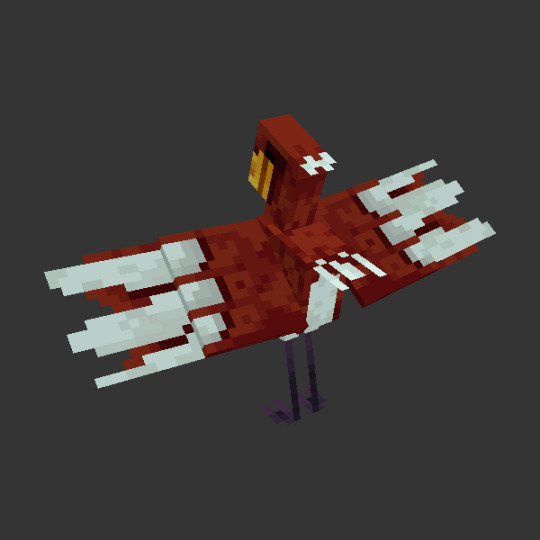

First place of Bird Poll #4, the Shoebill- but not really! I'm naming it Goliathia, after an ancestor ov shoebills! That's right, ancient bird babeyyyyyy
This one was actually really weird to model; up until the shading ov the entire texture for the model was done, it just looked insanely silly, but I'm pretty happy with where its at. To tie it in with the sniffer, I've used two ov the same colour palettes (the reds & the yellows)!
Goliathias will NOT spawn in Lush Caves, but Sniffers can dig up their eggs there! Their eggs hatch similarly to Sniffer eggs, and their young like to ride around on Sniffers.
They'll be aggressive towards pretty much any mob smaller than a wolf, but can be easily placated by being near glowberries. They themselves can also be ridden, and glide down from ledges gently, making them a pretty useful mount.
this is for my mod Valley of Plenty! all posts r tagged accordingly
#minecraft#mc#mod development#valley of plenty#technically posting this a little bit early but there's kinda no way shoebill doesn't win at this point
116 notes
·
View notes
Text
Xenerodiops mycter

By Ripley Cook
Etymology: The strangely appearing Heron
First Described By: Rasmussen et al., 1987
Classification: Dinosauromorpha, Dinosauriformes, Dracohors, Dinosauria, Saurischia, Eusaurischia, Theropoda, Neotheropoda, Averostra, Tetanurae, Orionides, Avetheropoda, Coelurosauria, Tyrannoraptora, Maniraptoromorpha, Maniraptoriformes, Maniraptora, Pennaraptora, Paraves, Eumaniraptora, Averaptora, Avialae, Euavialae, Avebrevicauda, Pygostaylia, Ornithothoraces, Euornithes, Ornithuromorpha, Ornithurae, Neornithes, Neognathae, Neoaves, Aequorlitornithes, Ardeae, Aequornithes, Pelecaniformes
Status: Extinct
Time and Place: Between 30.2 and 29.5 million years ago, in the Rupelian of the Oligocene


Xenerodiops is known from the Jebel Qatrani Formation of Egypt
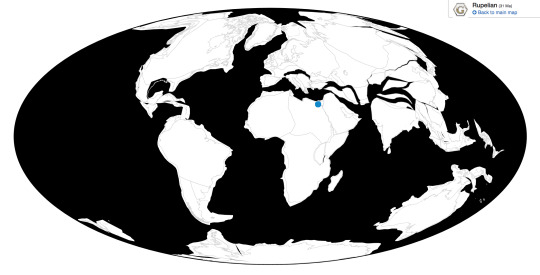
Physical Description: Xenerodiops is a strange intermediate bird, slightly smaller than the smallest living stork - probably no longer than 70 centimeters or so. Still, it was larger than most living species of herons - so this wasn’t a small bird. It was fairly similar to storks too, in terms of the shapes of the known bones, so it seems likely that Xenerodiops was a precursor to that modern dinosaur group. It had a very strong, pointed bill, though, more like herons than storks - adapted for biting and even stabbing prey, rather than snapping up food trapped in vegetation. This weirdly short, heavy bill was also curved downwards, so different from living herons and somewhat similar to living storks. Its wings were heavy and robust, and in general, this was a very sturdy sort of bird.
Diet: Xenerodiops probably fed on animals and, if it is a heron-stork like thing as supposed, it is logical to assume these animals were found in bodies of water.
Behavior: Without more fossils of Xenerodiops, it is difficult to piece together how it would have looked - especially without legs, which would point to whether or not this bird waded in the water as those birds it seems to be closely related to do. Still, for now, that is the simplest explanation for its general lifestyle. Its large beak would have been useful in reaching out into bodies of water and grabbing food sharply, possibly even stabbing it; being curved downwards, it could have been used similar to living stork bills in probing for food in the water. It is possible, then, that Xenerodiops did similar things, going into the water and grabbing as much food with its strong beak as possible, sensing food where it could not see. With its strong, robust wings, Xenerodiops would have been a powerful flier, able to gain a lot of movement from very few flaps of their wings. As with other dinosaurs, Xenerodiops would have probably taken care of its young; whether or not it did so in large colonies or in isolated nests is difficult to tell at this point.

Creatures of the Jebel Qatrani by Stanton F. Fink, CC By-SA 2.5
Ecosystem: The Jebel Qatrani Formation is a fairly famous ecosystem from the Oligocene, a time when the weird creatures of the Eocene and Paleocene were beginning to transition into animals similar to those we see today. In addition to almost-modern forms, of course, there were also the fun offshoots, which is probably where Xenerodiops lies. Jebel Qatrani is famous for its transitional fossils, especially among mammals. It was a thick swamp ecosystem, extremely warm and wet - a tropical wetland, filled with animals taking advantage of the lush plantlife. This place was filled with a variety of mammals - dugong relatives like Eosiren, a transitional primate Aegyptopithecus, a weird pointy heavyset mammal Arsinoitherium, the slightly more hippo-esque but still weird Bothriogenys, giant hyraxes, the lemur-like Plesiopithecus, the false ungulate Herodotius, the strange carnivores Ptolemaia and Qarunavus, a marsupial Peratherium, hyaenodonts like Metapterodon, and an alarming number of rodents. Turtles and crocodilians and other reptiles were plentiful too, like the turtle Albertwoodemys, the crocodile Crocodylus megarhinus, a gharial Eogavialis, and the snake Pterosphenus. As for fish, there were a variety of tetras, snakeheads, and catfish.
Xenerodiops wasn’t the only dinosaur in this environment, either. Many other weird birds were found here, some just as odd and unplaceable as Xenerodiops. For example, Eremopezus lived here - it was some sort of large, flightless bird. Beyond that, we have no idea. There was also the (iconic and large) swimming flamingo, Palaelodus. An even larger sort of shoebill than the living one, Goliathia, prowled the swamps. A giant true stork, Palaeoephippiorhynchus, was a major fixture of the landscape. There were Jacanas like Nuphranassa and Janipes, turacos like Crinifer, and even birds of prey. In a lot of ways, therefore, the birds of the area were even weirder than the mammals - and Xenerodiops was just one of many.
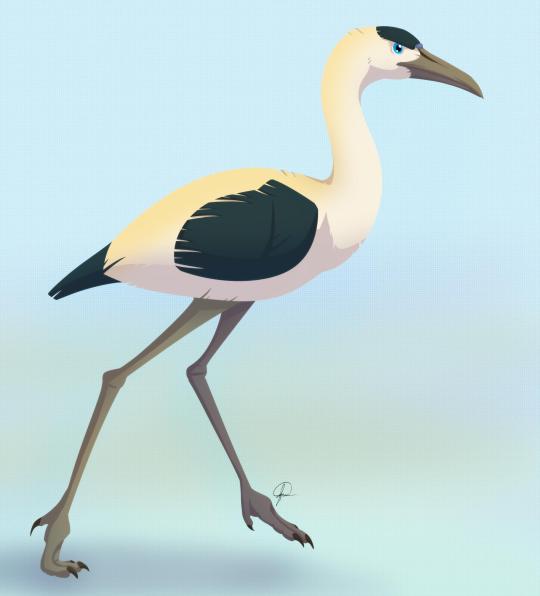
By José Carlos Cortés
Other: What exactly Xenerodiops is remains a mystery. Its weird combination of characteristics points to it being in the group of dinosaurs including a large number of living water birds - and both storks and herons. However, research has shown that storks and herons are actually somewhat removed from each other, with herons being more closely related to pelicans, shoebills, ibises, and even boobies than to storks. Is Xenerodiops, then, a weird, transitional, extinct member of this group of dinosaurs? Is it another evolutionary experiment altogether, with traits of many members of this group? Something else entirely? Only more fossils will help us to make the picture clearer. Some of these traits are shared in other weird waterbirds of the Paleogene (such as Mangystania), and it is entirely possible that there is an extinct clade of these animals, separate from all living members of the group.
~ By Meig Dickson
Sources under the Cut
Mayr, G. 2009. Paleogene Fossil Birds. Springer-Verlag Berlin Heidelberg.
Mayr, G. 2017. Avian Evolution: The Fossil Record of Birds and its Paleobiological Significance. Topics in Paleobiology, Wiley Blackwell. West Sussex.
Mlíkovský, Jiří (2003), "Early Miocene Birds of Djebel Zelten, Libya" (PDF), Časopis Národního muzea, Řada přírodovědná, 172 (1–4): 114–120.
Rasmussen, D. T., S. L. Olson, E. L. Simons. 1987. Fossil Birds from the Oligocene Jebel Qatrani Formation Fayum Province, Egypt. Smithsonian Contributions to Paleobiology 62: 1 - 19.
Zvonov, E. A., N. V. Zelenkov, I. G. Danilov. 2015. A New unusual waterbird (Aves, ?Suliformes) from the Eocene of Kazakhstan. Journal of Vertebrate Paleontology: e1035783.
#Xenerodiops mycter#Xenerodiops#Dinosaur#Aequorlitornithian#Bird#Birds#Ardeaen#Factfile#Dinosaurs#Birblr#Palaeoblr#Carnivore#Water Wednesday#Africa#Paleogene#paleontology#prehistory#prehistoric life#biology#a dinosaur a day#a-dinosaur-a-day#dinosaur of the day#dinosaur-of-the-day#science#nature
219 notes
·
View notes
Text

irl the Goliathia is a known (long extinct) ancestor ov the modern Shoebill, which Loftwings are based off!




First place of Bird Poll #4, the Shoebill- but not really! I'm naming it Goliathia, after an ancestor ov shoebills! That's right, ancient bird babeyyyyyy
This one was actually really weird to model; up until the shading ov the entire texture for the model was done, it just looked insanely silly, but I'm pretty happy with where its at. To tie it in with the sniffer, I've used two ov the same colour palettes (the reds & the yellows)!
Goliathias will NOT spawn in Lush Caves, but Sniffers can dig up their eggs there! Their eggs hatch similarly to Sniffer eggs, and their young like to ride around on Sniffers.
They'll be aggressive towards pretty much any mob smaller than a wolf, but can be easily placated by being near glowberries. They themselves can also be ridden, and glide down from ledges gently, making them a pretty useful mount.
this is for my mod Valley of Plenty! all posts r tagged accordingly
116 notes
·
View notes